Analysis of Innovation Theories and Airbnb's Future Development
VerifiedAdded on 2020/11/12
|15
|3689
|232
Report
AI Summary
This report provides an in-depth analysis of innovation theories and their application to Airbnb's business model. It begins with an introduction to innovation and its importance for organizations, then delves into two key theories: Diffusion of Innovation (DOI) and Disruptive Innovation Theory. The DOI theory, including its adopter categories and influencing factors, is explored in detail, followed by an examination of Disruptive Innovation Theory and its implications. The report then presents a historical overview of Airbnb's development, including its products, services, and key milestones. Finally, the report connects these theories to Airbnb's historical and potential future developments, offering insights into how the company can leverage innovation for continued growth and market leadership. The report is a comprehensive overview of innovation management within the context of a leading platform in the sharing economy.
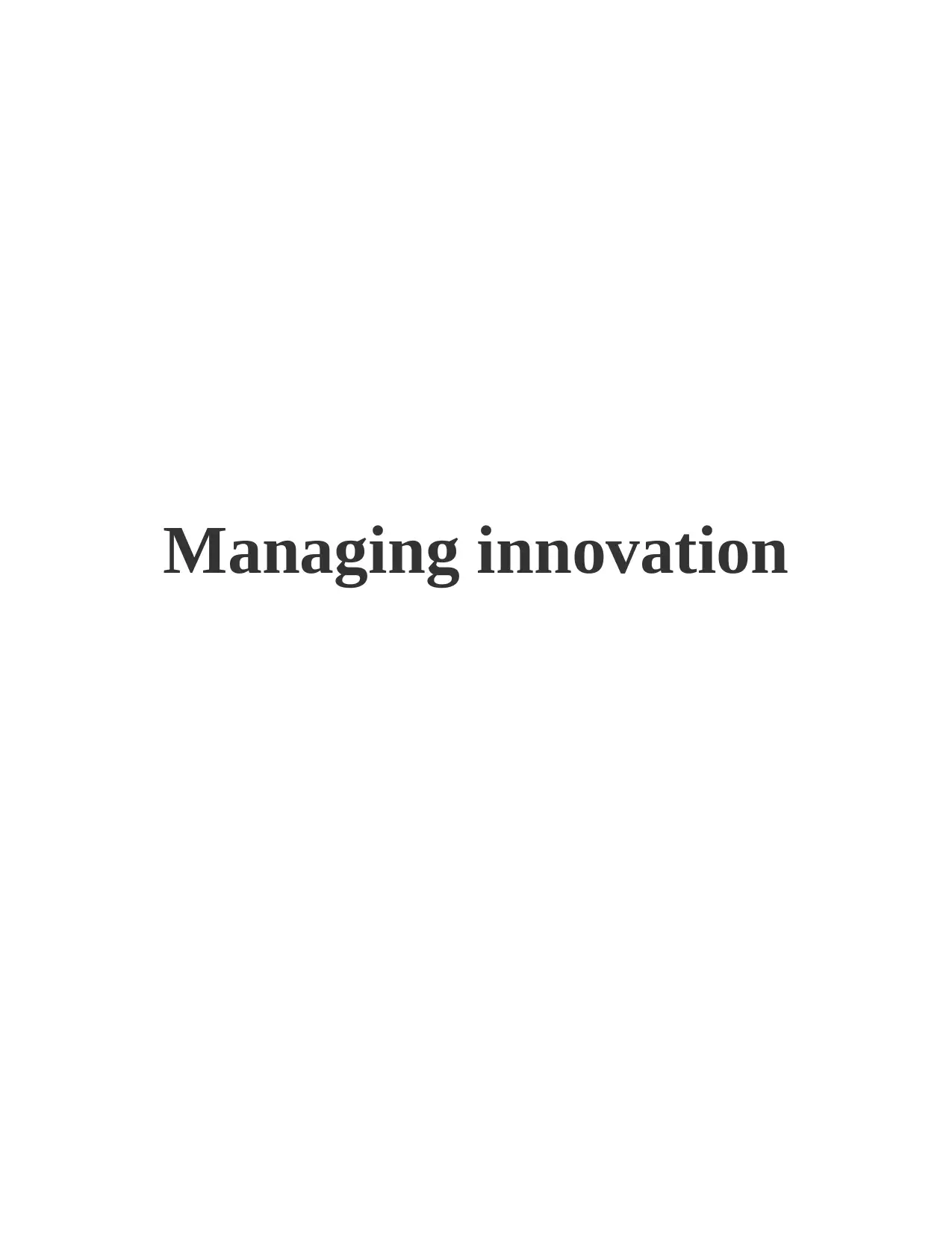
Managing innovation
Paraphrase This Document
Need a fresh take? Get an instant paraphrase of this document with our AI Paraphraser
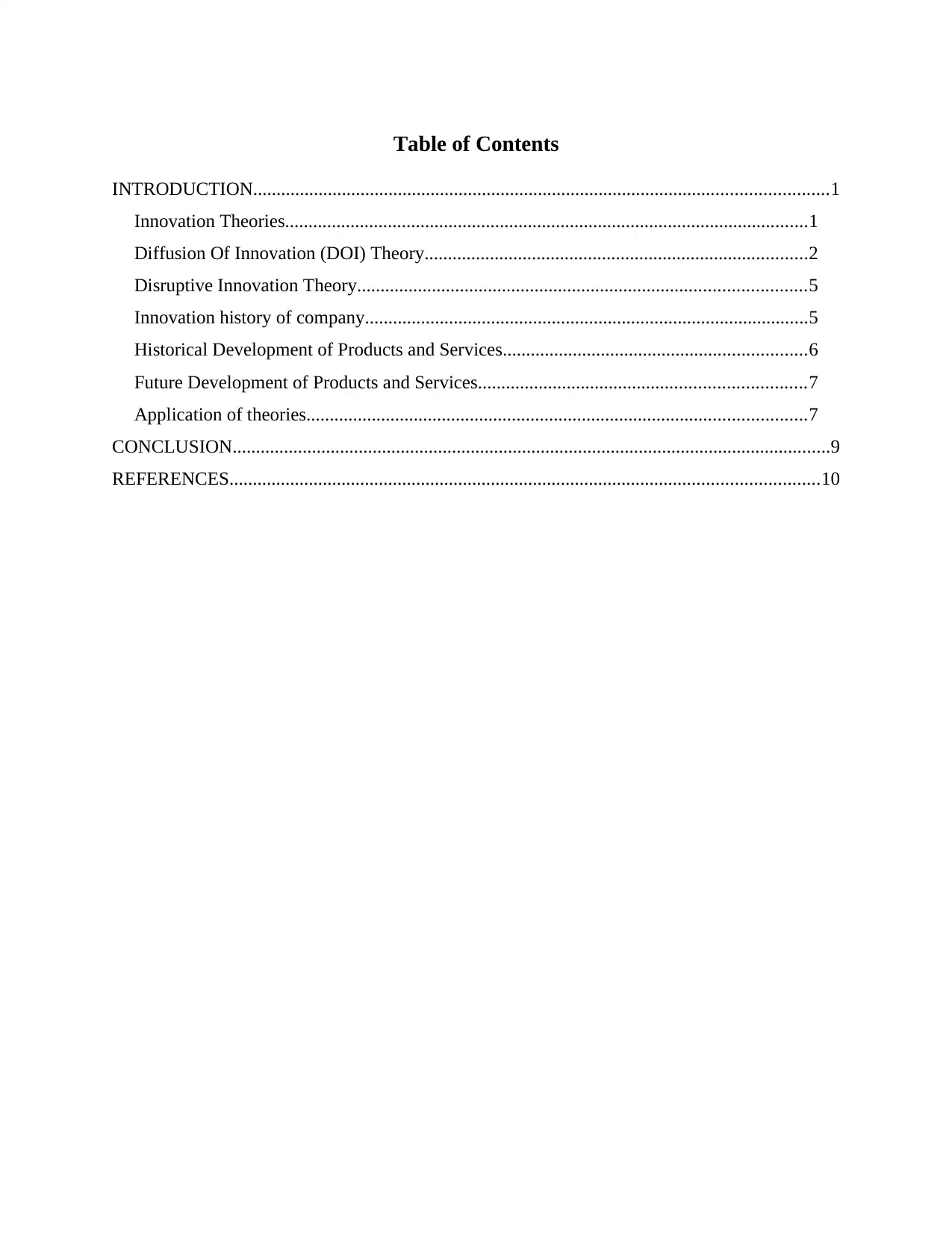
Table of Contents
INTRODUCTION...........................................................................................................................1
Innovation Theories................................................................................................................1
Diffusion Of Innovation (DOI) Theory..................................................................................2
Disruptive Innovation Theory................................................................................................5
Innovation history of company...............................................................................................5
Historical Development of Products and Services.................................................................6
Future Development of Products and Services......................................................................7
Application of theories...........................................................................................................7
CONCLUSION................................................................................................................................9
REFERENCES..............................................................................................................................10
INTRODUCTION...........................................................................................................................1
Innovation Theories................................................................................................................1
Diffusion Of Innovation (DOI) Theory..................................................................................2
Disruptive Innovation Theory................................................................................................5
Innovation history of company...............................................................................................5
Historical Development of Products and Services.................................................................6
Future Development of Products and Services......................................................................7
Application of theories...........................................................................................................7
CONCLUSION................................................................................................................................9
REFERENCES..............................................................................................................................10
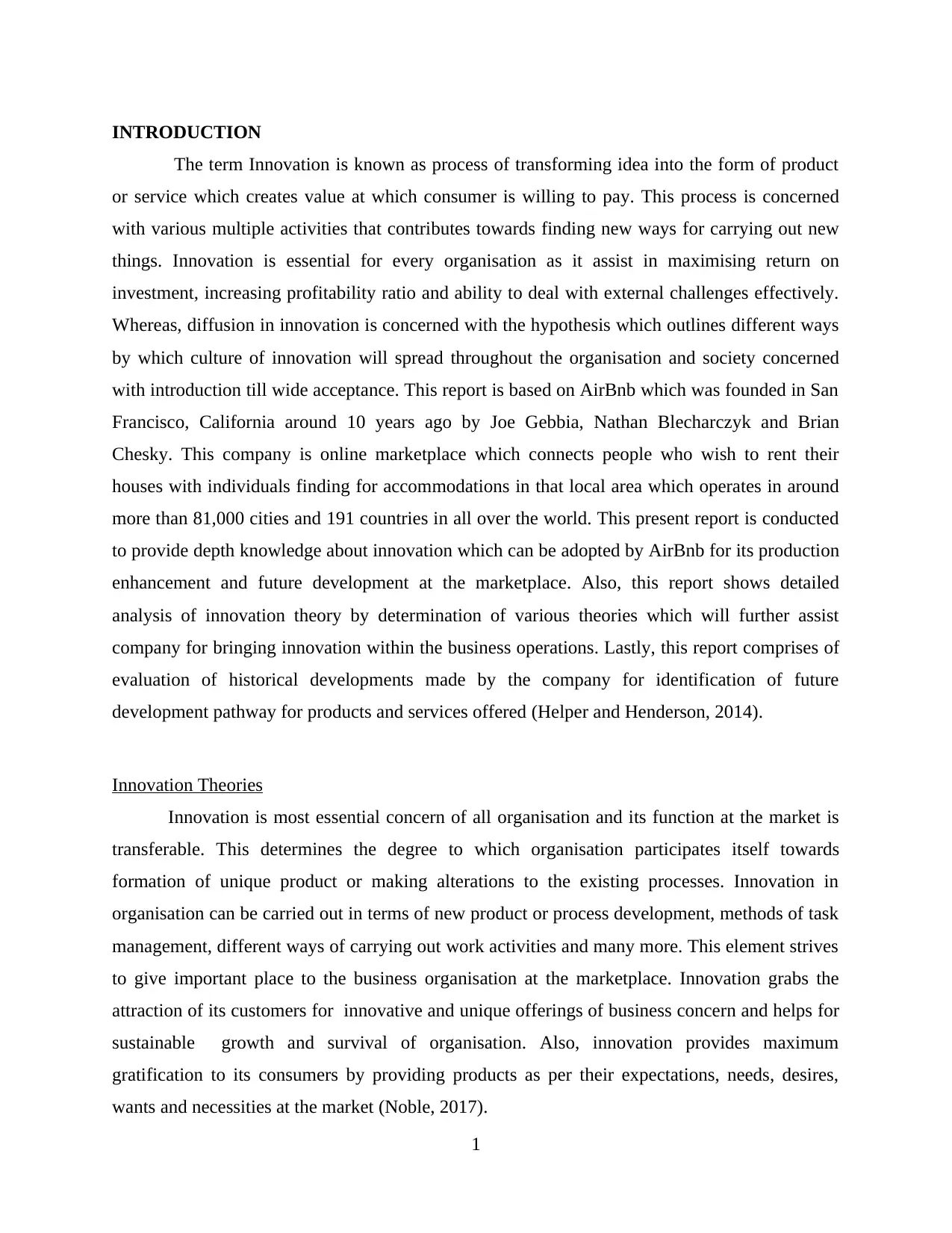
INTRODUCTION
The term Innovation is known as process of transforming idea into the form of product
or service which creates value at which consumer is willing to pay. This process is concerned
with various multiple activities that contributes towards finding new ways for carrying out new
things. Innovation is essential for every organisation as it assist in maximising return on
investment, increasing profitability ratio and ability to deal with external challenges effectively.
Whereas, diffusion in innovation is concerned with the hypothesis which outlines different ways
by which culture of innovation will spread throughout the organisation and society concerned
with introduction till wide acceptance. This report is based on AirBnb which was founded in San
Francisco, California around 10 years ago by Joe Gebbia, Nathan Blecharczyk and Brian
Chesky. This company is online marketplace which connects people who wish to rent their
houses with individuals finding for accommodations in that local area which operates in around
more than 81,000 cities and 191 countries in all over the world. This present report is conducted
to provide depth knowledge about innovation which can be adopted by AirBnb for its production
enhancement and future development at the marketplace. Also, this report shows detailed
analysis of innovation theory by determination of various theories which will further assist
company for bringing innovation within the business operations. Lastly, this report comprises of
evaluation of historical developments made by the company for identification of future
development pathway for products and services offered (Helper and Henderson, 2014).
Innovation Theories
Innovation is most essential concern of all organisation and its function at the market is
transferable. This determines the degree to which organisation participates itself towards
formation of unique product or making alterations to the existing processes. Innovation in
organisation can be carried out in terms of new product or process development, methods of task
management, different ways of carrying out work activities and many more. This element strives
to give important place to the business organisation at the marketplace. Innovation grabs the
attraction of its customers for innovative and unique offerings of business concern and helps for
sustainable growth and survival of organisation. Also, innovation provides maximum
gratification to its consumers by providing products as per their expectations, needs, desires,
wants and necessities at the market (Noble, 2017).
1
The term Innovation is known as process of transforming idea into the form of product
or service which creates value at which consumer is willing to pay. This process is concerned
with various multiple activities that contributes towards finding new ways for carrying out new
things. Innovation is essential for every organisation as it assist in maximising return on
investment, increasing profitability ratio and ability to deal with external challenges effectively.
Whereas, diffusion in innovation is concerned with the hypothesis which outlines different ways
by which culture of innovation will spread throughout the organisation and society concerned
with introduction till wide acceptance. This report is based on AirBnb which was founded in San
Francisco, California around 10 years ago by Joe Gebbia, Nathan Blecharczyk and Brian
Chesky. This company is online marketplace which connects people who wish to rent their
houses with individuals finding for accommodations in that local area which operates in around
more than 81,000 cities and 191 countries in all over the world. This present report is conducted
to provide depth knowledge about innovation which can be adopted by AirBnb for its production
enhancement and future development at the marketplace. Also, this report shows detailed
analysis of innovation theory by determination of various theories which will further assist
company for bringing innovation within the business operations. Lastly, this report comprises of
evaluation of historical developments made by the company for identification of future
development pathway for products and services offered (Helper and Henderson, 2014).
Innovation Theories
Innovation is most essential concern of all organisation and its function at the market is
transferable. This determines the degree to which organisation participates itself towards
formation of unique product or making alterations to the existing processes. Innovation in
organisation can be carried out in terms of new product or process development, methods of task
management, different ways of carrying out work activities and many more. This element strives
to give important place to the business organisation at the marketplace. Innovation grabs the
attraction of its customers for innovative and unique offerings of business concern and helps for
sustainable growth and survival of organisation. Also, innovation provides maximum
gratification to its consumers by providing products as per their expectations, needs, desires,
wants and necessities at the market (Noble, 2017).
1
⊘ This is a preview!⊘
Do you want full access?
Subscribe today to unlock all pages.

Trusted by 1+ million students worldwide
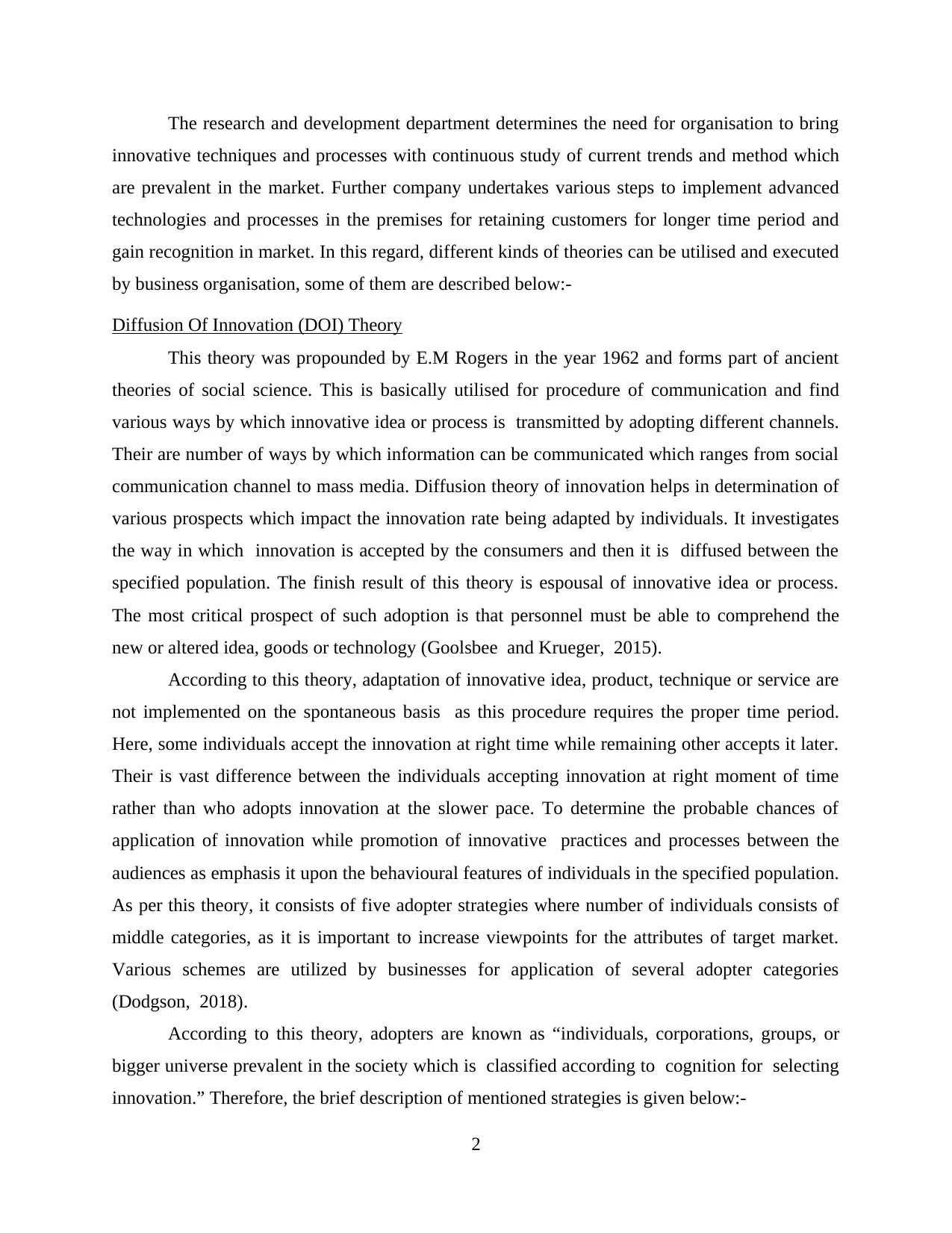
The research and development department determines the need for organisation to bring
innovative techniques and processes with continuous study of current trends and method which
are prevalent in the market. Further company undertakes various steps to implement advanced
technologies and processes in the premises for retaining customers for longer time period and
gain recognition in market. In this regard, different kinds of theories can be utilised and executed
by business organisation, some of them are described below:-
Diffusion Of Innovation (DOI) Theory
This theory was propounded by E.M Rogers in the year 1962 and forms part of ancient
theories of social science. This is basically utilised for procedure of communication and find
various ways by which innovative idea or process is transmitted by adopting different channels.
Their are number of ways by which information can be communicated which ranges from social
communication channel to mass media. Diffusion theory of innovation helps in determination of
various prospects which impact the innovation rate being adapted by individuals. It investigates
the way in which innovation is accepted by the consumers and then it is diffused between the
specified population. The finish result of this theory is espousal of innovative idea or process.
The most critical prospect of such adoption is that personnel must be able to comprehend the
new or altered idea, goods or technology (Goolsbee and Krueger, 2015).
According to this theory, adaptation of innovative idea, product, technique or service are
not implemented on the spontaneous basis as this procedure requires the proper time period.
Here, some individuals accept the innovation at right time while remaining other accepts it later.
Their is vast difference between the individuals accepting innovation at right moment of time
rather than who adopts innovation at the slower pace. To determine the probable chances of
application of innovation while promotion of innovative practices and processes between the
audiences as emphasis it upon the behavioural features of individuals in the specified population.
As per this theory, it consists of five adopter strategies where number of individuals consists of
middle categories, as it is important to increase viewpoints for the attributes of target market.
Various schemes are utilized by businesses for application of several adopter categories
(Dodgson, 2018).
According to this theory, adopters are known as “individuals, corporations, groups, or
bigger universe prevalent in the society which is classified according to cognition for selecting
innovation.” Therefore, the brief description of mentioned strategies is given below:-
2
innovative techniques and processes with continuous study of current trends and method which
are prevalent in the market. Further company undertakes various steps to implement advanced
technologies and processes in the premises for retaining customers for longer time period and
gain recognition in market. In this regard, different kinds of theories can be utilised and executed
by business organisation, some of them are described below:-
Diffusion Of Innovation (DOI) Theory
This theory was propounded by E.M Rogers in the year 1962 and forms part of ancient
theories of social science. This is basically utilised for procedure of communication and find
various ways by which innovative idea or process is transmitted by adopting different channels.
Their are number of ways by which information can be communicated which ranges from social
communication channel to mass media. Diffusion theory of innovation helps in determination of
various prospects which impact the innovation rate being adapted by individuals. It investigates
the way in which innovation is accepted by the consumers and then it is diffused between the
specified population. The finish result of this theory is espousal of innovative idea or process.
The most critical prospect of such adoption is that personnel must be able to comprehend the
new or altered idea, goods or technology (Goolsbee and Krueger, 2015).
According to this theory, adaptation of innovative idea, product, technique or service are
not implemented on the spontaneous basis as this procedure requires the proper time period.
Here, some individuals accept the innovation at right time while remaining other accepts it later.
Their is vast difference between the individuals accepting innovation at right moment of time
rather than who adopts innovation at the slower pace. To determine the probable chances of
application of innovation while promotion of innovative practices and processes between the
audiences as emphasis it upon the behavioural features of individuals in the specified population.
As per this theory, it consists of five adopter strategies where number of individuals consists of
middle categories, as it is important to increase viewpoints for the attributes of target market.
Various schemes are utilized by businesses for application of several adopter categories
(Dodgson, 2018).
According to this theory, adopters are known as “individuals, corporations, groups, or
bigger universe prevalent in the society which is classified according to cognition for selecting
innovation.” Therefore, the brief description of mentioned strategies is given below:-
2
Paraphrase This Document
Need a fresh take? Get an instant paraphrase of this document with our AI Paraphraser
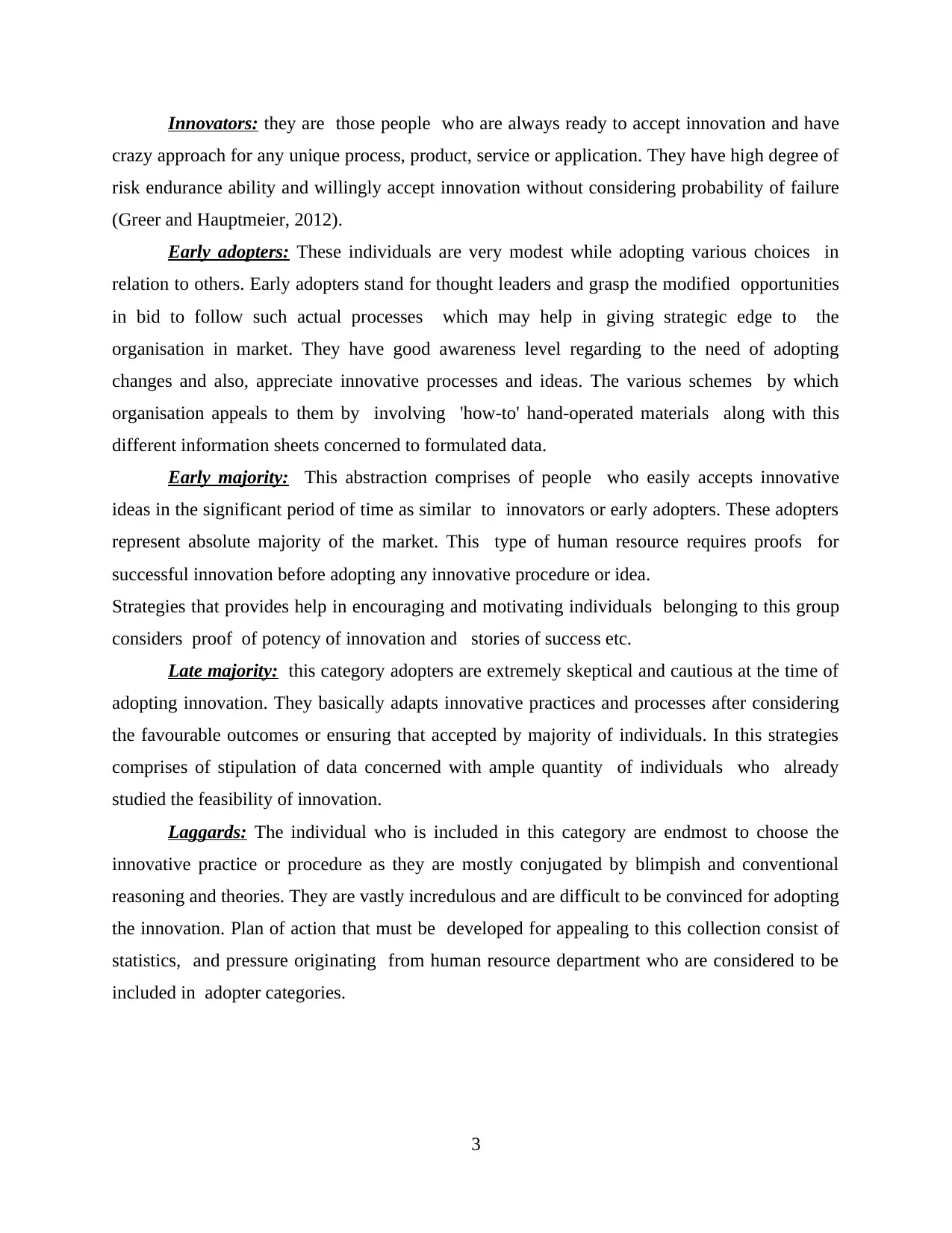
Innovators: they are those people who are always ready to accept innovation and have
crazy approach for any unique process, product, service or application. They have high degree of
risk endurance ability and willingly accept innovation without considering probability of failure
(Greer and Hauptmeier, 2012).
Early adopters: These individuals are very modest while adopting various choices in
relation to others. Early adopters stand for thought leaders and grasp the modified opportunities
in bid to follow such actual processes which may help in giving strategic edge to the
organisation in market. They have good awareness level regarding to the need of adopting
changes and also, appreciate innovative processes and ideas. The various schemes by which
organisation appeals to them by involving 'how-to' hand-operated materials along with this
different information sheets concerned to formulated data.
Early majority: This abstraction comprises of people who easily accepts innovative
ideas in the significant period of time as similar to innovators or early adopters. These adopters
represent absolute majority of the market. This type of human resource requires proofs for
successful innovation before adopting any innovative procedure or idea.
Strategies that provides help in encouraging and motivating individuals belonging to this group
considers proof of potency of innovation and stories of success etc.
Late majority: this category adopters are extremely skeptical and cautious at the time of
adopting innovation. They basically adapts innovative practices and processes after considering
the favourable outcomes or ensuring that accepted by majority of individuals. In this strategies
comprises of stipulation of data concerned with ample quantity of individuals who already
studied the feasibility of innovation.
Laggards: The individual who is included in this category are endmost to choose the
innovative practice or procedure as they are mostly conjugated by blimpish and conventional
reasoning and theories. They are vastly incredulous and are difficult to be convinced for adopting
the innovation. Plan of action that must be developed for appealing to this collection consist of
statistics, and pressure originating from human resource department who are considered to be
included in adopter categories.
3
crazy approach for any unique process, product, service or application. They have high degree of
risk endurance ability and willingly accept innovation without considering probability of failure
(Greer and Hauptmeier, 2012).
Early adopters: These individuals are very modest while adopting various choices in
relation to others. Early adopters stand for thought leaders and grasp the modified opportunities
in bid to follow such actual processes which may help in giving strategic edge to the
organisation in market. They have good awareness level regarding to the need of adopting
changes and also, appreciate innovative processes and ideas. The various schemes by which
organisation appeals to them by involving 'how-to' hand-operated materials along with this
different information sheets concerned to formulated data.
Early majority: This abstraction comprises of people who easily accepts innovative
ideas in the significant period of time as similar to innovators or early adopters. These adopters
represent absolute majority of the market. This type of human resource requires proofs for
successful innovation before adopting any innovative procedure or idea.
Strategies that provides help in encouraging and motivating individuals belonging to this group
considers proof of potency of innovation and stories of success etc.
Late majority: this category adopters are extremely skeptical and cautious at the time of
adopting innovation. They basically adapts innovative practices and processes after considering
the favourable outcomes or ensuring that accepted by majority of individuals. In this strategies
comprises of stipulation of data concerned with ample quantity of individuals who already
studied the feasibility of innovation.
Laggards: The individual who is included in this category are endmost to choose the
innovative practice or procedure as they are mostly conjugated by blimpish and conventional
reasoning and theories. They are vastly incredulous and are difficult to be convinced for adopting
the innovation. Plan of action that must be developed for appealing to this collection consist of
statistics, and pressure originating from human resource department who are considered to be
included in adopter categories.
3
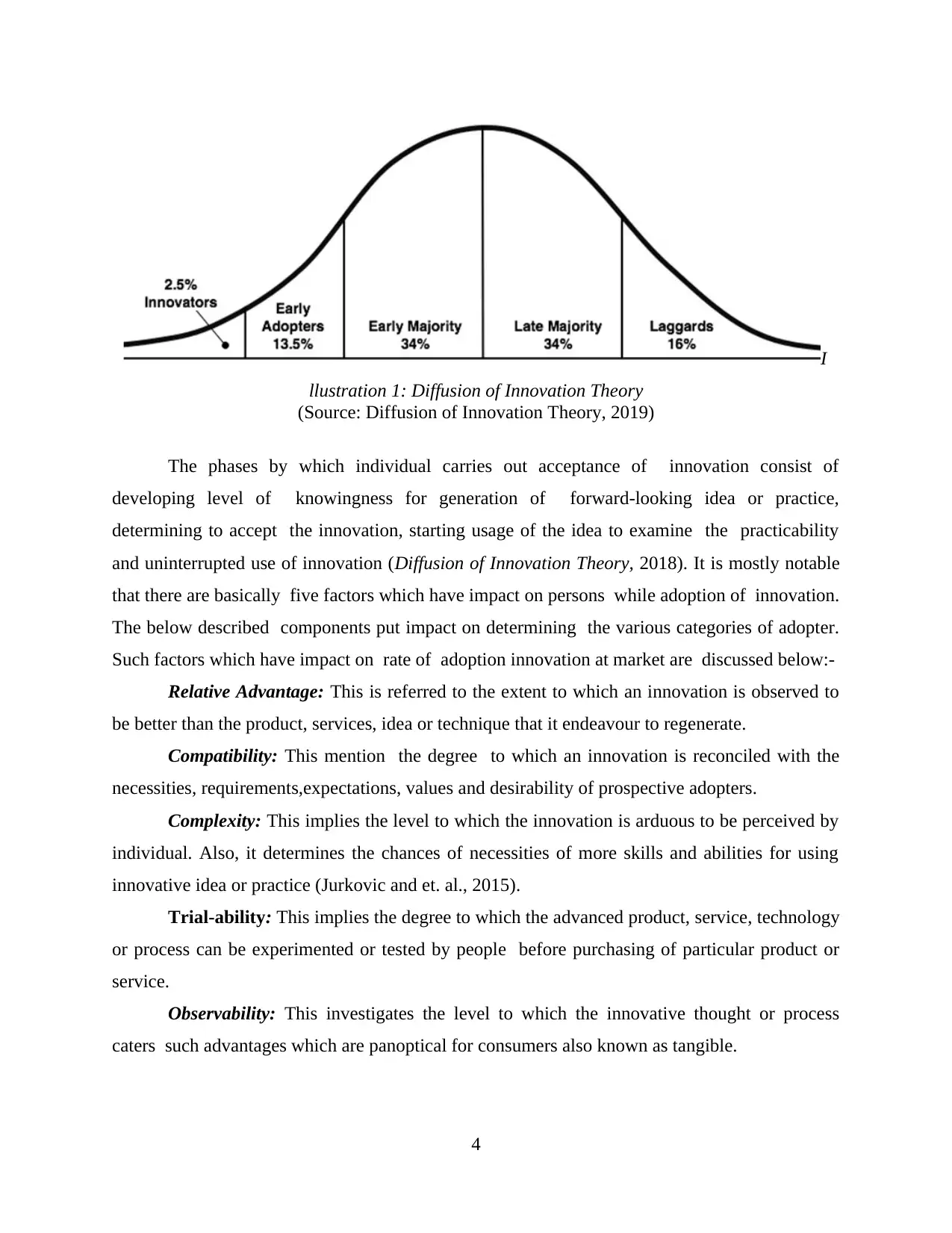
(Source: Diffusion of Innovation Theory, 2019)
The phases by which individual carries out acceptance of innovation consist of
developing level of knowingness for generation of forward-looking idea or practice,
determining to accept the innovation, starting usage of the idea to examine the practicability
and uninterrupted use of innovation (Diffusion of Innovation Theory, 2018). It is mostly notable
that there are basically five factors which have impact on persons while adoption of innovation.
The below described components put impact on determining the various categories of adopter.
Such factors which have impact on rate of adoption innovation at market are discussed below:-
Relative Advantage: This is referred to the extent to which an innovation is observed to
be better than the product, services, idea or technique that it endeavour to regenerate.
Compatibility: This mention the degree to which an innovation is reconciled with the
necessities, requirements,expectations, values and desirability of prospective adopters.
Complexity: This implies the level to which the innovation is arduous to be perceived by
individual. Also, it determines the chances of necessities of more skills and abilities for using
innovative idea or practice (Jurkovic and et. al., 2015).
Trial-ability: This implies the degree to which the advanced product, service, technology
or process can be experimented or tested by people before purchasing of particular product or
service.
Observability: This investigates the level to which the innovative thought or process
caters such advantages which are panoptical for consumers also known as tangible.
4
I
llustration 1: Diffusion of Innovation Theory
The phases by which individual carries out acceptance of innovation consist of
developing level of knowingness for generation of forward-looking idea or practice,
determining to accept the innovation, starting usage of the idea to examine the practicability
and uninterrupted use of innovation (Diffusion of Innovation Theory, 2018). It is mostly notable
that there are basically five factors which have impact on persons while adoption of innovation.
The below described components put impact on determining the various categories of adopter.
Such factors which have impact on rate of adoption innovation at market are discussed below:-
Relative Advantage: This is referred to the extent to which an innovation is observed to
be better than the product, services, idea or technique that it endeavour to regenerate.
Compatibility: This mention the degree to which an innovation is reconciled with the
necessities, requirements,expectations, values and desirability of prospective adopters.
Complexity: This implies the level to which the innovation is arduous to be perceived by
individual. Also, it determines the chances of necessities of more skills and abilities for using
innovative idea or practice (Jurkovic and et. al., 2015).
Trial-ability: This implies the degree to which the advanced product, service, technology
or process can be experimented or tested by people before purchasing of particular product or
service.
Observability: This investigates the level to which the innovative thought or process
caters such advantages which are panoptical for consumers also known as tangible.
4
I
llustration 1: Diffusion of Innovation Theory
⊘ This is a preview!⊘
Do you want full access?
Subscribe today to unlock all pages.

Trusted by 1+ million students worldwide
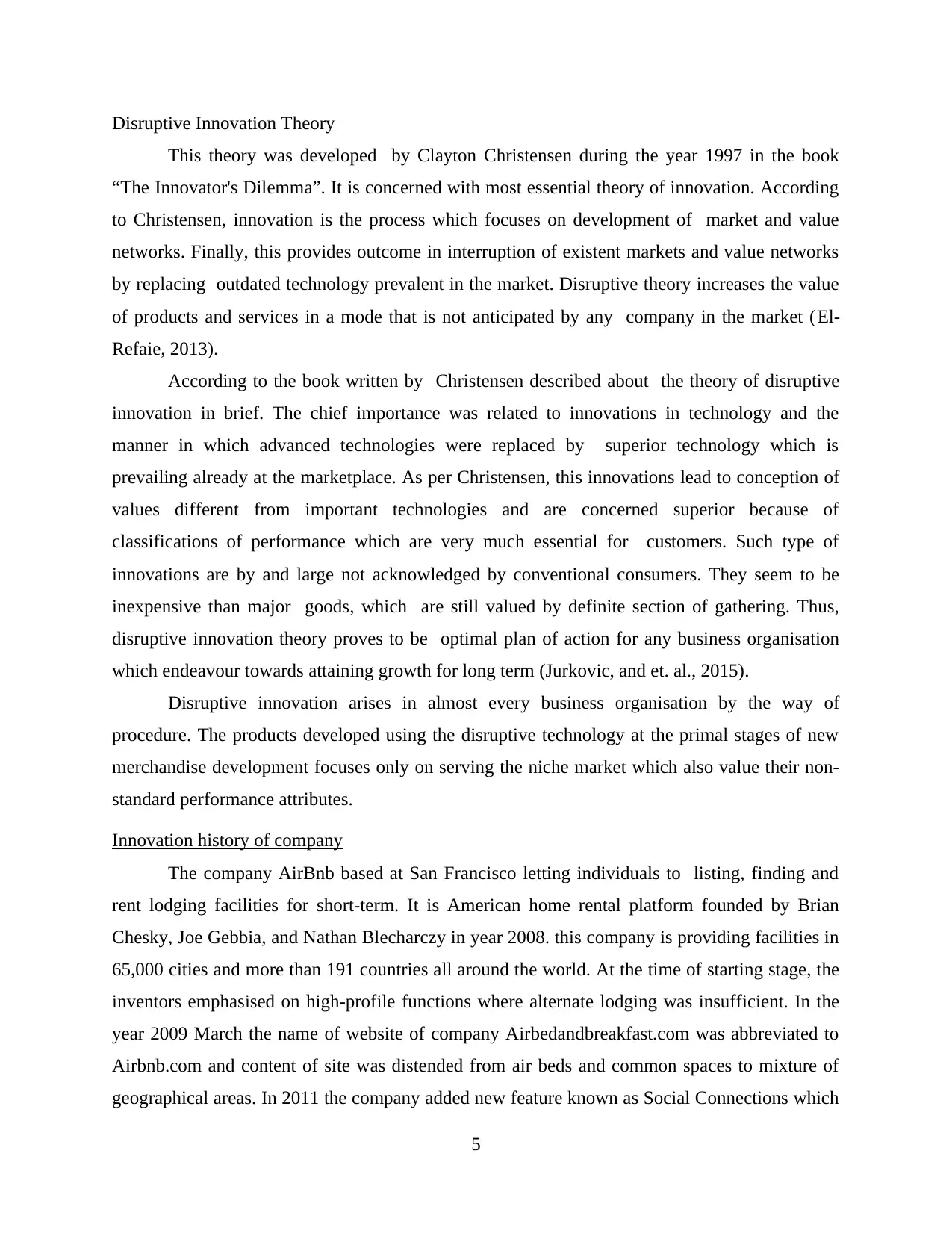
Disruptive Innovation Theory
This theory was developed by Clayton Christensen during the year 1997 in the book
“The Innovator's Dilemma”. It is concerned with most essential theory of innovation. According
to Christensen, innovation is the process which focuses on development of market and value
networks. Finally, this provides outcome in interruption of existent markets and value networks
by replacing outdated technology prevalent in the market. Disruptive theory increases the value
of products and services in a mode that is not anticipated by any company in the market (El-
Refaie, 2013).
According to the book written by Christensen described about the theory of disruptive
innovation in brief. The chief importance was related to innovations in technology and the
manner in which advanced technologies were replaced by superior technology which is
prevailing already at the marketplace. As per Christensen, this innovations lead to conception of
values different from important technologies and are concerned superior because of
classifications of performance which are very much essential for customers. Such type of
innovations are by and large not acknowledged by conventional consumers. They seem to be
inexpensive than major goods, which are still valued by definite section of gathering. Thus,
disruptive innovation theory proves to be optimal plan of action for any business organisation
which endeavour towards attaining growth for long term (Jurkovic, and et. al., 2015).
Disruptive innovation arises in almost every business organisation by the way of
procedure. The products developed using the disruptive technology at the primal stages of new
merchandise development focuses only on serving the niche market which also value their non-
standard performance attributes.
Innovation history of company
The company AirBnb based at San Francisco letting individuals to listing, finding and
rent lodging facilities for short-term. It is American home rental platform founded by Brian
Chesky, Joe Gebbia, and Nathan Blecharczy in year 2008. this company is providing facilities in
65,000 cities and more than 191 countries all around the world. At the time of starting stage, the
inventors emphasised on high-profile functions where alternate lodging was insufficient. In the
year 2009 March the name of website of company Airbedandbreakfast.com was abbreviated to
Airbnb.com and content of site was distended from air beds and common spaces to mixture of
geographical areas. In 2011 the company added new feature known as Social Connections which
5
This theory was developed by Clayton Christensen during the year 1997 in the book
“The Innovator's Dilemma”. It is concerned with most essential theory of innovation. According
to Christensen, innovation is the process which focuses on development of market and value
networks. Finally, this provides outcome in interruption of existent markets and value networks
by replacing outdated technology prevalent in the market. Disruptive theory increases the value
of products and services in a mode that is not anticipated by any company in the market (El-
Refaie, 2013).
According to the book written by Christensen described about the theory of disruptive
innovation in brief. The chief importance was related to innovations in technology and the
manner in which advanced technologies were replaced by superior technology which is
prevailing already at the marketplace. As per Christensen, this innovations lead to conception of
values different from important technologies and are concerned superior because of
classifications of performance which are very much essential for customers. Such type of
innovations are by and large not acknowledged by conventional consumers. They seem to be
inexpensive than major goods, which are still valued by definite section of gathering. Thus,
disruptive innovation theory proves to be optimal plan of action for any business organisation
which endeavour towards attaining growth for long term (Jurkovic, and et. al., 2015).
Disruptive innovation arises in almost every business organisation by the way of
procedure. The products developed using the disruptive technology at the primal stages of new
merchandise development focuses only on serving the niche market which also value their non-
standard performance attributes.
Innovation history of company
The company AirBnb based at San Francisco letting individuals to listing, finding and
rent lodging facilities for short-term. It is American home rental platform founded by Brian
Chesky, Joe Gebbia, and Nathan Blecharczy in year 2008. this company is providing facilities in
65,000 cities and more than 191 countries all around the world. At the time of starting stage, the
inventors emphasised on high-profile functions where alternate lodging was insufficient. In the
year 2009 March the name of website of company Airbedandbreakfast.com was abbreviated to
Airbnb.com and content of site was distended from air beds and common spaces to mixture of
geographical areas. In 2011 the company added new feature known as Social Connections which
5
Paraphrase This Document
Need a fresh take? Get an instant paraphrase of this document with our AI Paraphraser
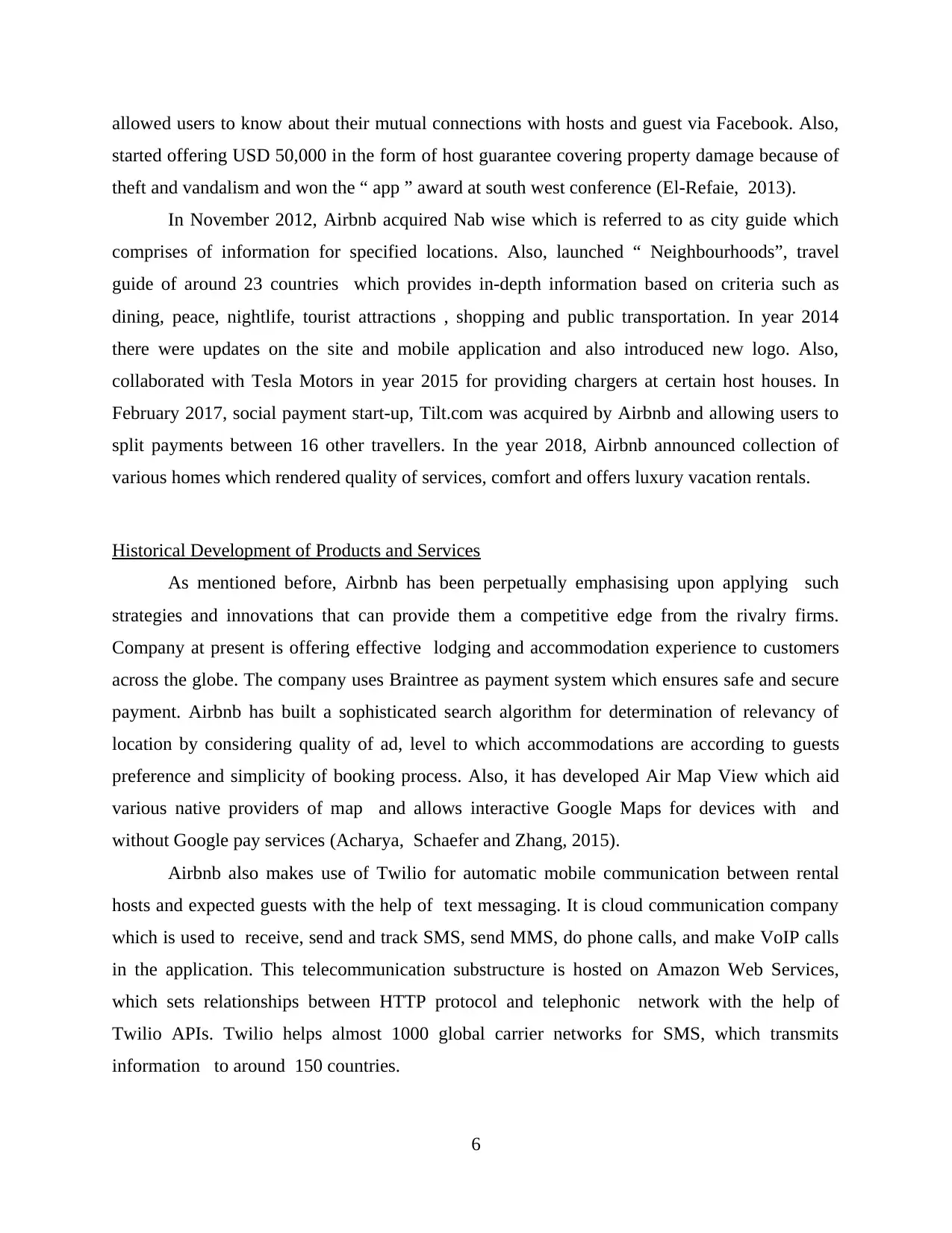
allowed users to know about their mutual connections with hosts and guest via Facebook. Also,
started offering USD 50,000 in the form of host guarantee covering property damage because of
theft and vandalism and won the “ app ” award at south west conference (El-Refaie, 2013).
In November 2012, Airbnb acquired Nab wise which is referred to as city guide which
comprises of information for specified locations. Also, launched “ Neighbourhoods”, travel
guide of around 23 countries which provides in-depth information based on criteria such as
dining, peace, nightlife, tourist attractions , shopping and public transportation. In year 2014
there were updates on the site and mobile application and also introduced new logo. Also,
collaborated with Tesla Motors in year 2015 for providing chargers at certain host houses. In
February 2017, social payment start-up, Tilt.com was acquired by Airbnb and allowing users to
split payments between 16 other travellers. In the year 2018, Airbnb announced collection of
various homes which rendered quality of services, comfort and offers luxury vacation rentals.
Historical Development of Products and Services
As mentioned before, Airbnb has been perpetually emphasising upon applying such
strategies and innovations that can provide them a competitive edge from the rivalry firms.
Company at present is offering effective lodging and accommodation experience to customers
across the globe. The company uses Braintree as payment system which ensures safe and secure
payment. Airbnb has built a sophisticated search algorithm for determination of relevancy of
location by considering quality of ad, level to which accommodations are according to guests
preference and simplicity of booking process. Also, it has developed Air Map View which aid
various native providers of map and allows interactive Google Maps for devices with and
without Google pay services (Acharya, Schaefer and Zhang, 2015).
Airbnb also makes use of Twilio for automatic mobile communication between rental
hosts and expected guests with the help of text messaging. It is cloud communication company
which is used to receive, send and track SMS, send MMS, do phone calls, and make VoIP calls
in the application. This telecommunication substructure is hosted on Amazon Web Services,
which sets relationships between HTTP protocol and telephonic network with the help of
Twilio APIs. Twilio helps almost 1000 global carrier networks for SMS, which transmits
information to around 150 countries.
6
started offering USD 50,000 in the form of host guarantee covering property damage because of
theft and vandalism and won the “ app ” award at south west conference (El-Refaie, 2013).
In November 2012, Airbnb acquired Nab wise which is referred to as city guide which
comprises of information for specified locations. Also, launched “ Neighbourhoods”, travel
guide of around 23 countries which provides in-depth information based on criteria such as
dining, peace, nightlife, tourist attractions , shopping and public transportation. In year 2014
there were updates on the site and mobile application and also introduced new logo. Also,
collaborated with Tesla Motors in year 2015 for providing chargers at certain host houses. In
February 2017, social payment start-up, Tilt.com was acquired by Airbnb and allowing users to
split payments between 16 other travellers. In the year 2018, Airbnb announced collection of
various homes which rendered quality of services, comfort and offers luxury vacation rentals.
Historical Development of Products and Services
As mentioned before, Airbnb has been perpetually emphasising upon applying such
strategies and innovations that can provide them a competitive edge from the rivalry firms.
Company at present is offering effective lodging and accommodation experience to customers
across the globe. The company uses Braintree as payment system which ensures safe and secure
payment. Airbnb has built a sophisticated search algorithm for determination of relevancy of
location by considering quality of ad, level to which accommodations are according to guests
preference and simplicity of booking process. Also, it has developed Air Map View which aid
various native providers of map and allows interactive Google Maps for devices with and
without Google pay services (Acharya, Schaefer and Zhang, 2015).
Airbnb also makes use of Twilio for automatic mobile communication between rental
hosts and expected guests with the help of text messaging. It is cloud communication company
which is used to receive, send and track SMS, send MMS, do phone calls, and make VoIP calls
in the application. This telecommunication substructure is hosted on Amazon Web Services,
which sets relationships between HTTP protocol and telephonic network with the help of
Twilio APIs. Twilio helps almost 1000 global carrier networks for SMS, which transmits
information to around 150 countries.
6
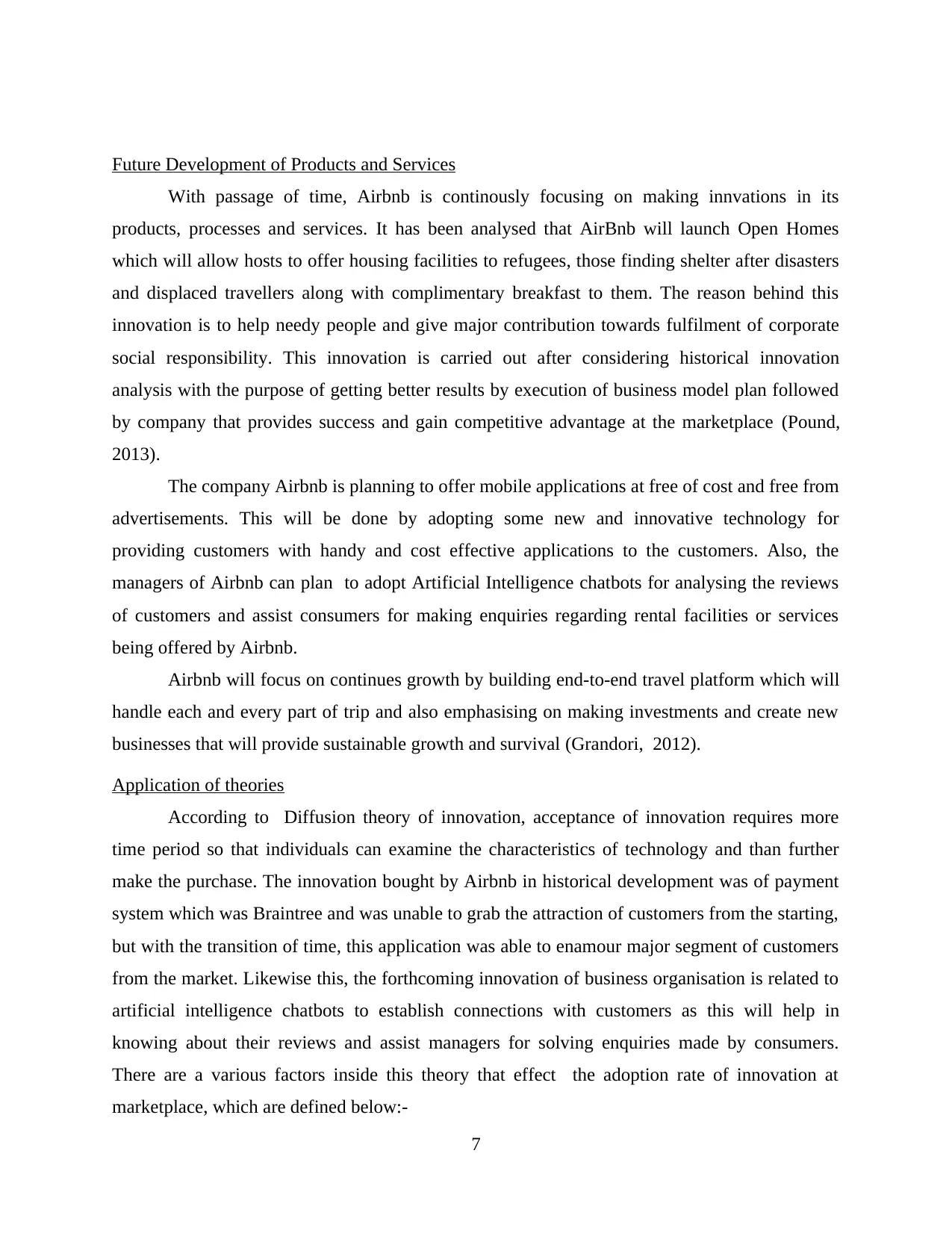
Future Development of Products and Services
With passage of time, Airbnb is continously focusing on making innvations in its
products, processes and services. It has been analysed that AirBnb will launch Open Homes
which will allow hosts to offer housing facilities to refugees, those finding shelter after disasters
and displaced travellers along with complimentary breakfast to them. The reason behind this
innovation is to help needy people and give major contribution towards fulfilment of corporate
social responsibility. This innovation is carried out after considering historical innovation
analysis with the purpose of getting better results by execution of business model plan followed
by company that provides success and gain competitive advantage at the marketplace (Pound,
2013).
The company Airbnb is planning to offer mobile applications at free of cost and free from
advertisements. This will be done by adopting some new and innovative technology for
providing customers with handy and cost effective applications to the customers. Also, the
managers of Airbnb can plan to adopt Artificial Intelligence chatbots for analysing the reviews
of customers and assist consumers for making enquiries regarding rental facilities or services
being offered by Airbnb.
Airbnb will focus on continues growth by building end-to-end travel platform which will
handle each and every part of trip and also emphasising on making investments and create new
businesses that will provide sustainable growth and survival (Grandori, 2012).
Application of theories
According to Diffusion theory of innovation, acceptance of innovation requires more
time period so that individuals can examine the characteristics of technology and than further
make the purchase. The innovation bought by Airbnb in historical development was of payment
system which was Braintree and was unable to grab the attraction of customers from the starting,
but with the transition of time, this application was able to enamour major segment of customers
from the market. Likewise this, the forthcoming innovation of business organisation is related to
artificial intelligence chatbots to establish connections with customers as this will help in
knowing about their reviews and assist managers for solving enquiries made by consumers.
There are a various factors inside this theory that effect the adoption rate of innovation at
marketplace, which are defined below:-
7
With passage of time, Airbnb is continously focusing on making innvations in its
products, processes and services. It has been analysed that AirBnb will launch Open Homes
which will allow hosts to offer housing facilities to refugees, those finding shelter after disasters
and displaced travellers along with complimentary breakfast to them. The reason behind this
innovation is to help needy people and give major contribution towards fulfilment of corporate
social responsibility. This innovation is carried out after considering historical innovation
analysis with the purpose of getting better results by execution of business model plan followed
by company that provides success and gain competitive advantage at the marketplace (Pound,
2013).
The company Airbnb is planning to offer mobile applications at free of cost and free from
advertisements. This will be done by adopting some new and innovative technology for
providing customers with handy and cost effective applications to the customers. Also, the
managers of Airbnb can plan to adopt Artificial Intelligence chatbots for analysing the reviews
of customers and assist consumers for making enquiries regarding rental facilities or services
being offered by Airbnb.
Airbnb will focus on continues growth by building end-to-end travel platform which will
handle each and every part of trip and also emphasising on making investments and create new
businesses that will provide sustainable growth and survival (Grandori, 2012).
Application of theories
According to Diffusion theory of innovation, acceptance of innovation requires more
time period so that individuals can examine the characteristics of technology and than further
make the purchase. The innovation bought by Airbnb in historical development was of payment
system which was Braintree and was unable to grab the attraction of customers from the starting,
but with the transition of time, this application was able to enamour major segment of customers
from the market. Likewise this, the forthcoming innovation of business organisation is related to
artificial intelligence chatbots to establish connections with customers as this will help in
knowing about their reviews and assist managers for solving enquiries made by consumers.
There are a various factors inside this theory that effect the adoption rate of innovation at
marketplace, which are defined below:-
7
⊘ This is a preview!⊘
Do you want full access?
Subscribe today to unlock all pages.

Trusted by 1+ million students worldwide
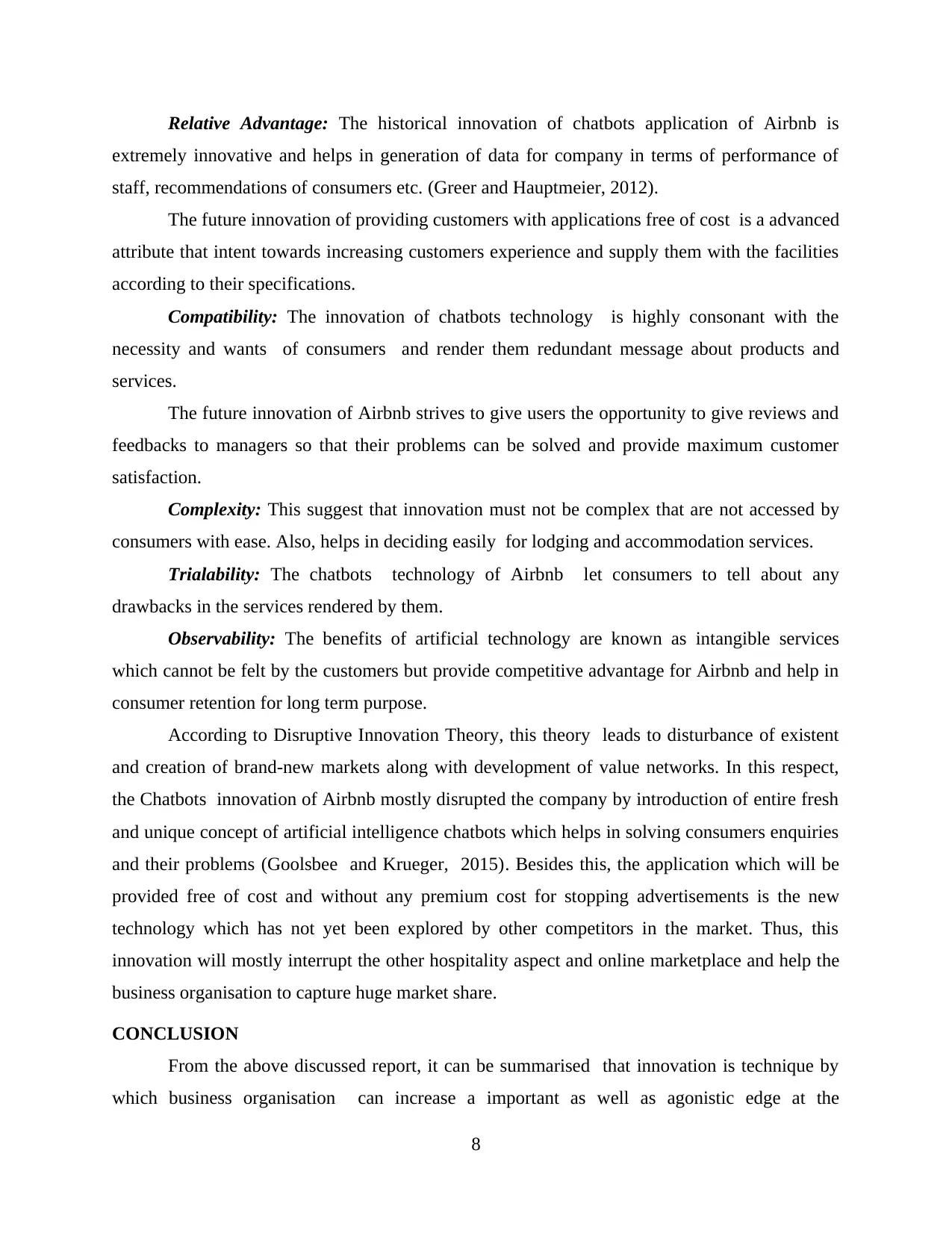
Relative Advantage: The historical innovation of chatbots application of Airbnb is
extremely innovative and helps in generation of data for company in terms of performance of
staff, recommendations of consumers etc. (Greer and Hauptmeier, 2012).
The future innovation of providing customers with applications free of cost is a advanced
attribute that intent towards increasing customers experience and supply them with the facilities
according to their specifications.
Compatibility: The innovation of chatbots technology is highly consonant with the
necessity and wants of consumers and render them redundant message about products and
services.
The future innovation of Airbnb strives to give users the opportunity to give reviews and
feedbacks to managers so that their problems can be solved and provide maximum customer
satisfaction.
Complexity: This suggest that innovation must not be complex that are not accessed by
consumers with ease. Also, helps in deciding easily for lodging and accommodation services.
Trialability: The chatbots technology of Airbnb let consumers to tell about any
drawbacks in the services rendered by them.
Observability: The benefits of artificial technology are known as intangible services
which cannot be felt by the customers but provide competitive advantage for Airbnb and help in
consumer retention for long term purpose.
According to Disruptive Innovation Theory, this theory leads to disturbance of existent
and creation of brand-new markets along with development of value networks. In this respect,
the Chatbots innovation of Airbnb mostly disrupted the company by introduction of entire fresh
and unique concept of artificial intelligence chatbots which helps in solving consumers enquiries
and their problems (Goolsbee and Krueger, 2015). Besides this, the application which will be
provided free of cost and without any premium cost for stopping advertisements is the new
technology which has not yet been explored by other competitors in the market. Thus, this
innovation will mostly interrupt the other hospitality aspect and online marketplace and help the
business organisation to capture huge market share.
CONCLUSION
From the above discussed report, it can be summarised that innovation is technique by
which business organisation can increase a important as well as agonistic edge at the
8
extremely innovative and helps in generation of data for company in terms of performance of
staff, recommendations of consumers etc. (Greer and Hauptmeier, 2012).
The future innovation of providing customers with applications free of cost is a advanced
attribute that intent towards increasing customers experience and supply them with the facilities
according to their specifications.
Compatibility: The innovation of chatbots technology is highly consonant with the
necessity and wants of consumers and render them redundant message about products and
services.
The future innovation of Airbnb strives to give users the opportunity to give reviews and
feedbacks to managers so that their problems can be solved and provide maximum customer
satisfaction.
Complexity: This suggest that innovation must not be complex that are not accessed by
consumers with ease. Also, helps in deciding easily for lodging and accommodation services.
Trialability: The chatbots technology of Airbnb let consumers to tell about any
drawbacks in the services rendered by them.
Observability: The benefits of artificial technology are known as intangible services
which cannot be felt by the customers but provide competitive advantage for Airbnb and help in
consumer retention for long term purpose.
According to Disruptive Innovation Theory, this theory leads to disturbance of existent
and creation of brand-new markets along with development of value networks. In this respect,
the Chatbots innovation of Airbnb mostly disrupted the company by introduction of entire fresh
and unique concept of artificial intelligence chatbots which helps in solving consumers enquiries
and their problems (Goolsbee and Krueger, 2015). Besides this, the application which will be
provided free of cost and without any premium cost for stopping advertisements is the new
technology which has not yet been explored by other competitors in the market. Thus, this
innovation will mostly interrupt the other hospitality aspect and online marketplace and help the
business organisation to capture huge market share.
CONCLUSION
From the above discussed report, it can be summarised that innovation is technique by
which business organisation can increase a important as well as agonistic edge at the
8
Paraphrase This Document
Need a fresh take? Get an instant paraphrase of this document with our AI Paraphraser
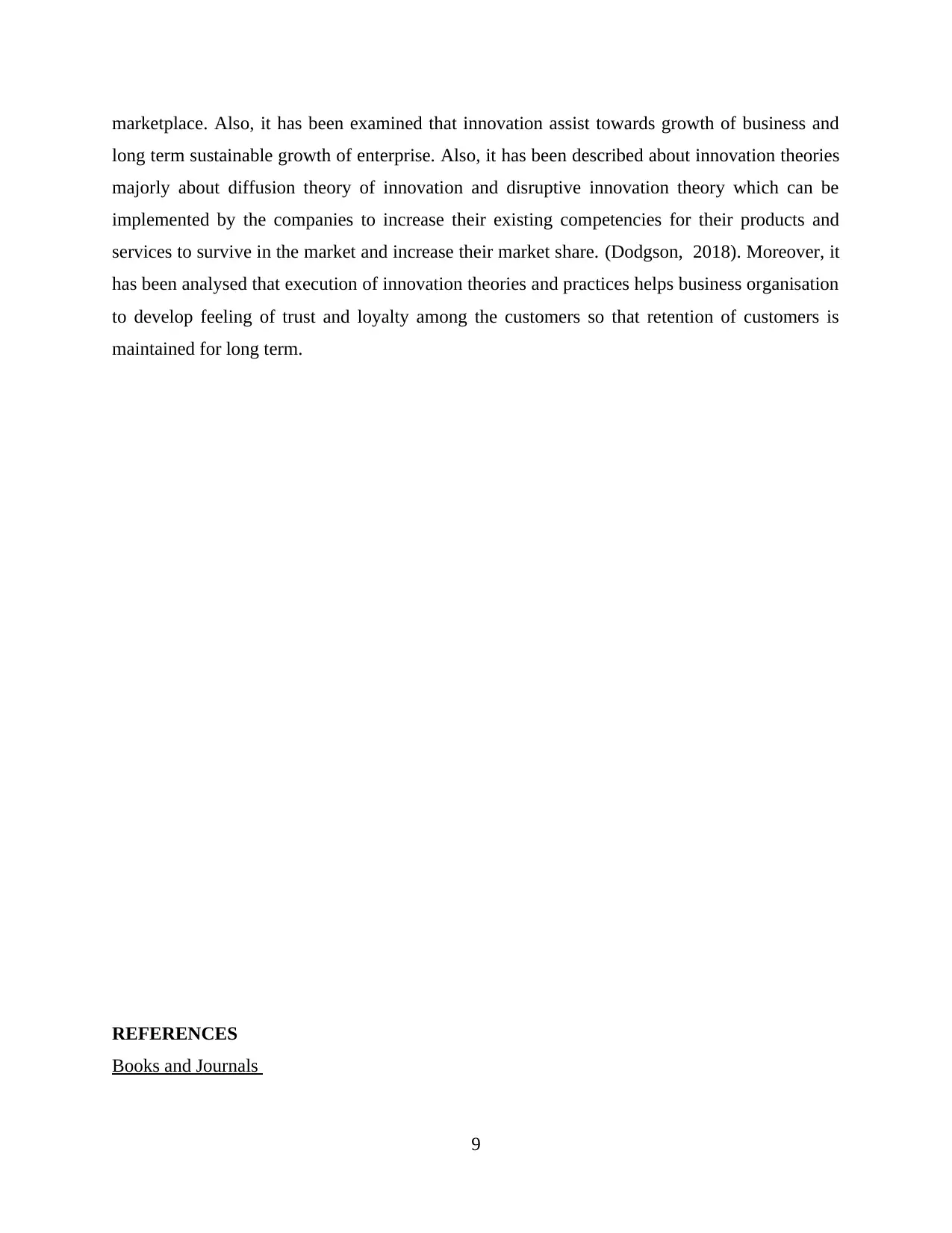
marketplace. Also, it has been examined that innovation assist towards growth of business and
long term sustainable growth of enterprise. Also, it has been described about innovation theories
majorly about diffusion theory of innovation and disruptive innovation theory which can be
implemented by the companies to increase their existing competencies for their products and
services to survive in the market and increase their market share. (Dodgson, 2018). Moreover, it
has been analysed that execution of innovation theories and practices helps business organisation
to develop feeling of trust and loyalty among the customers so that retention of customers is
maintained for long term.
REFERENCES
Books and Journals
9
long term sustainable growth of enterprise. Also, it has been described about innovation theories
majorly about diffusion theory of innovation and disruptive innovation theory which can be
implemented by the companies to increase their existing competencies for their products and
services to survive in the market and increase their market share. (Dodgson, 2018). Moreover, it
has been analysed that execution of innovation theories and practices helps business organisation
to develop feeling of trust and loyalty among the customers so that retention of customers is
maintained for long term.
REFERENCES
Books and Journals
9
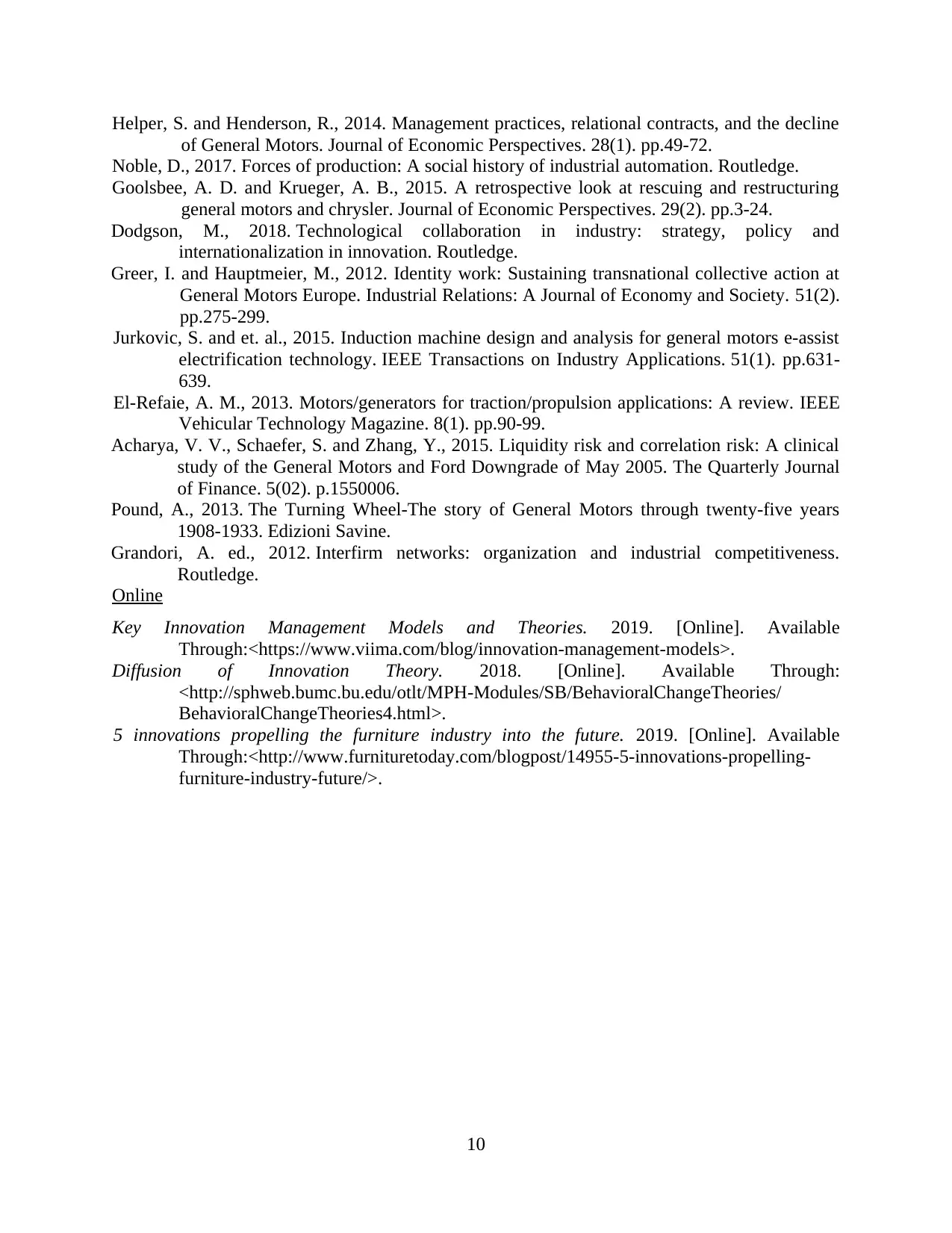
Helper, S. and Henderson, R., 2014. Management practices, relational contracts, and the decline
of General Motors. Journal of Economic Perspectives. 28(1). pp.49-72.
Noble, D., 2017. Forces of production: A social history of industrial automation. Routledge.
Goolsbee, A. D. and Krueger, A. B., 2015. A retrospective look at rescuing and restructuring
general motors and chrysler. Journal of Economic Perspectives. 29(2). pp.3-24.
Dodgson, M., 2018. Technological collaboration in industry: strategy, policy and
internationalization in innovation. Routledge.
Greer, I. and Hauptmeier, M., 2012. Identity work: Sustaining transnational collective action at
General Motors Europe. Industrial Relations: A Journal of Economy and Society. 51(2).
pp.275-299.
Jurkovic, S. and et. al., 2015. Induction machine design and analysis for general motors e-assist
electrification technology. IEEE Transactions on Industry Applications. 51(1). pp.631-
639.
El-Refaie, A. M., 2013. Motors/generators for traction/propulsion applications: A review. IEEE
Vehicular Technology Magazine. 8(1). pp.90-99.
Acharya, V. V., Schaefer, S. and Zhang, Y., 2015. Liquidity risk and correlation risk: A clinical
study of the General Motors and Ford Downgrade of May 2005. The Quarterly Journal
of Finance. 5(02). p.1550006.
Pound, A., 2013. The Turning Wheel-The story of General Motors through twenty-five years
1908-1933. Edizioni Savine.
Grandori, A. ed., 2012. Interfirm networks: organization and industrial competitiveness.
Routledge.
Online
Key Innovation Management Models and Theories. 2019. [Online]. Available
Through:<https://www.viima.com/blog/innovation-management-models>.
Diffusion of Innovation Theory. 2018. [Online]. Available Through:
<http://sphweb.bumc.bu.edu/otlt/MPH-Modules/SB/BehavioralChangeTheories/
BehavioralChangeTheories4.html>.
5 innovations propelling the furniture industry into the future. 2019. [Online]. Available
Through:<http://www.furnituretoday.com/blogpost/14955-5-innovations-propelling-
furniture-industry-future/>.
10
of General Motors. Journal of Economic Perspectives. 28(1). pp.49-72.
Noble, D., 2017. Forces of production: A social history of industrial automation. Routledge.
Goolsbee, A. D. and Krueger, A. B., 2015. A retrospective look at rescuing and restructuring
general motors and chrysler. Journal of Economic Perspectives. 29(2). pp.3-24.
Dodgson, M., 2018. Technological collaboration in industry: strategy, policy and
internationalization in innovation. Routledge.
Greer, I. and Hauptmeier, M., 2012. Identity work: Sustaining transnational collective action at
General Motors Europe. Industrial Relations: A Journal of Economy and Society. 51(2).
pp.275-299.
Jurkovic, S. and et. al., 2015. Induction machine design and analysis for general motors e-assist
electrification technology. IEEE Transactions on Industry Applications. 51(1). pp.631-
639.
El-Refaie, A. M., 2013. Motors/generators for traction/propulsion applications: A review. IEEE
Vehicular Technology Magazine. 8(1). pp.90-99.
Acharya, V. V., Schaefer, S. and Zhang, Y., 2015. Liquidity risk and correlation risk: A clinical
study of the General Motors and Ford Downgrade of May 2005. The Quarterly Journal
of Finance. 5(02). p.1550006.
Pound, A., 2013. The Turning Wheel-The story of General Motors through twenty-five years
1908-1933. Edizioni Savine.
Grandori, A. ed., 2012. Interfirm networks: organization and industrial competitiveness.
Routledge.
Online
Key Innovation Management Models and Theories. 2019. [Online]. Available
Through:<https://www.viima.com/blog/innovation-management-models>.
Diffusion of Innovation Theory. 2018. [Online]. Available Through:
<http://sphweb.bumc.bu.edu/otlt/MPH-Modules/SB/BehavioralChangeTheories/
BehavioralChangeTheories4.html>.
5 innovations propelling the furniture industry into the future. 2019. [Online]. Available
Through:<http://www.furnituretoday.com/blogpost/14955-5-innovations-propelling-
furniture-industry-future/>.
10
⊘ This is a preview!⊘
Do you want full access?
Subscribe today to unlock all pages.

Trusted by 1+ million students worldwide
1 out of 15
Related Documents
Your All-in-One AI-Powered Toolkit for Academic Success.
+13062052269
info@desklib.com
Available 24*7 on WhatsApp / Email
![[object Object]](/_next/static/media/star-bottom.7253800d.svg)
Unlock your academic potential
Copyright © 2020–2025 A2Z Services. All Rights Reserved. Developed and managed by ZUCOL.





